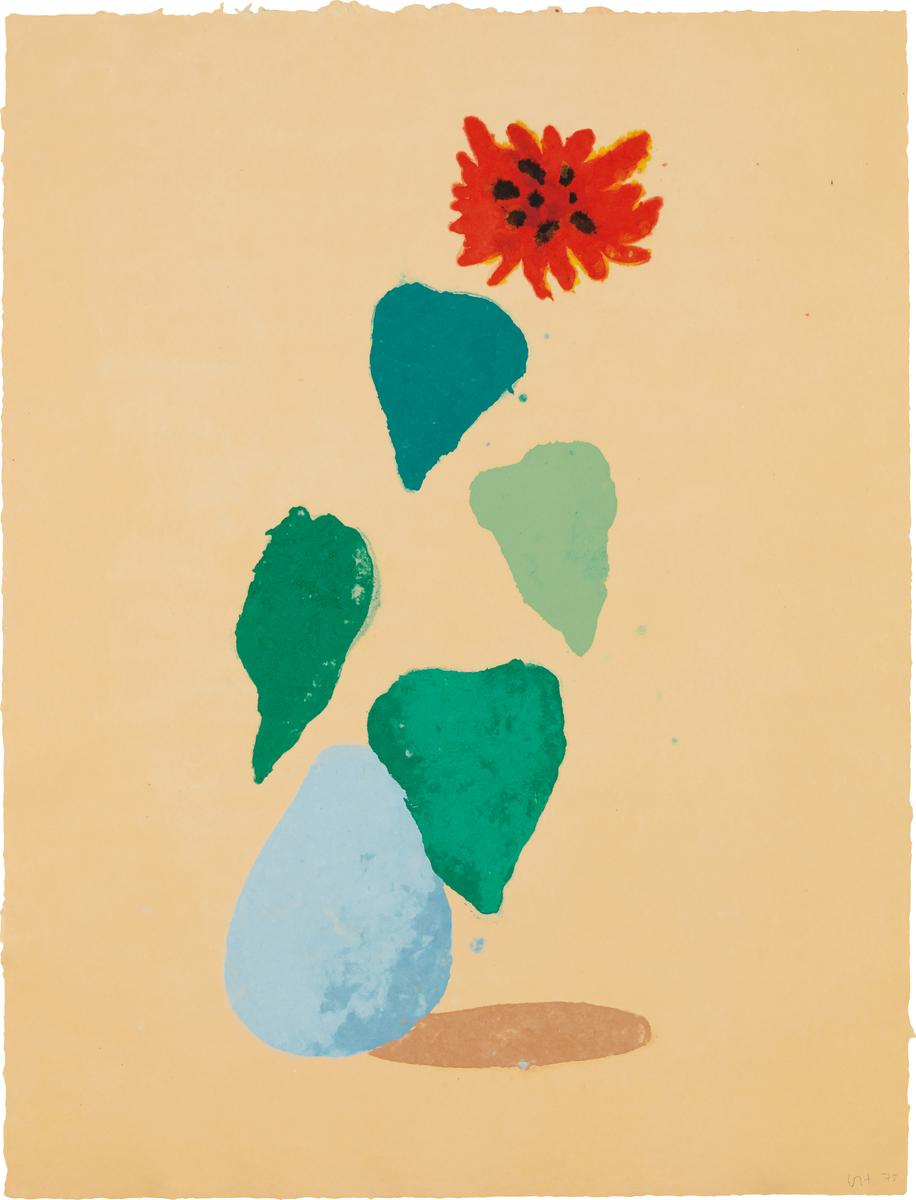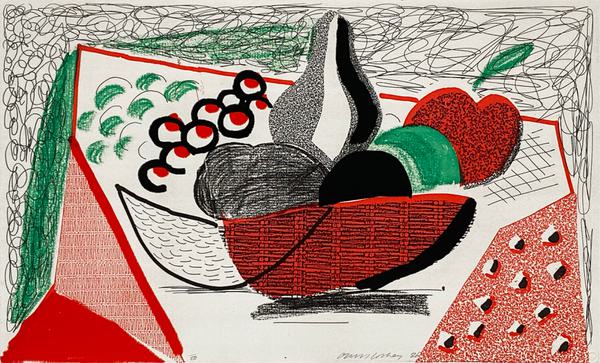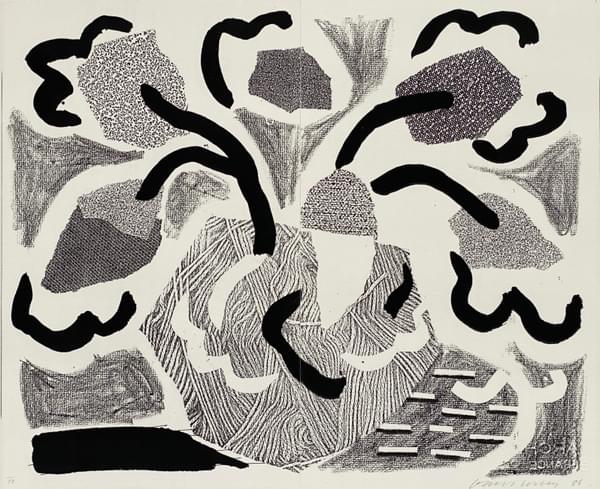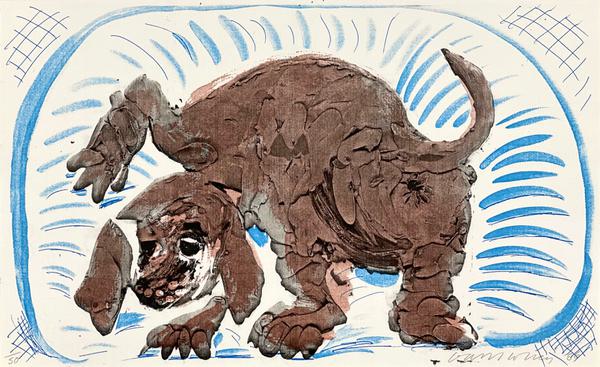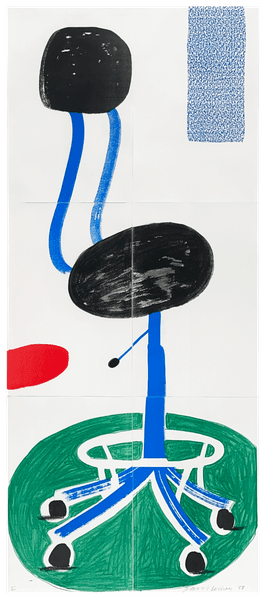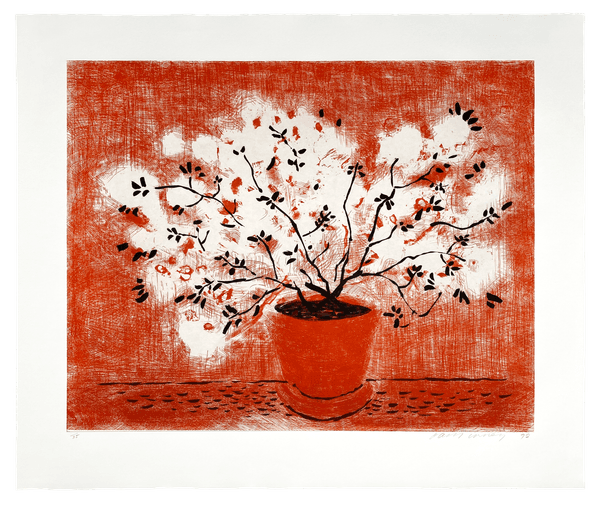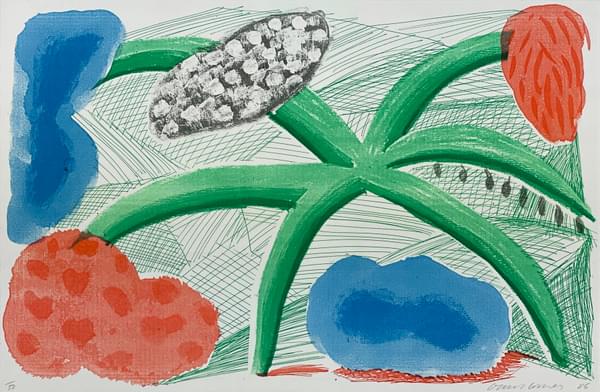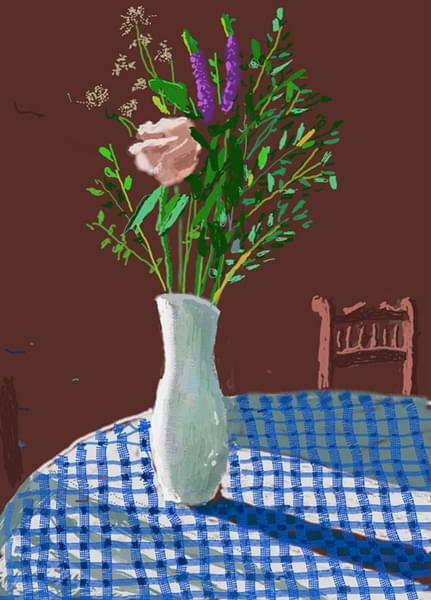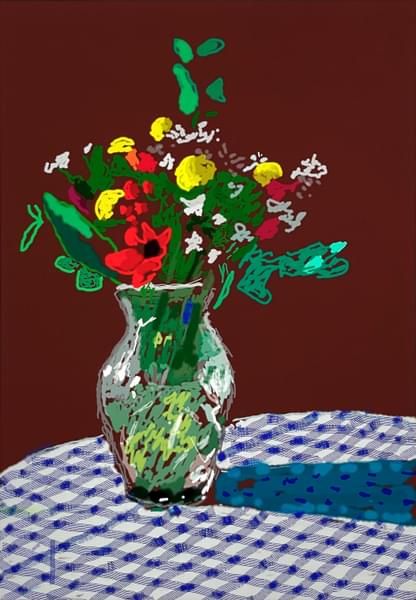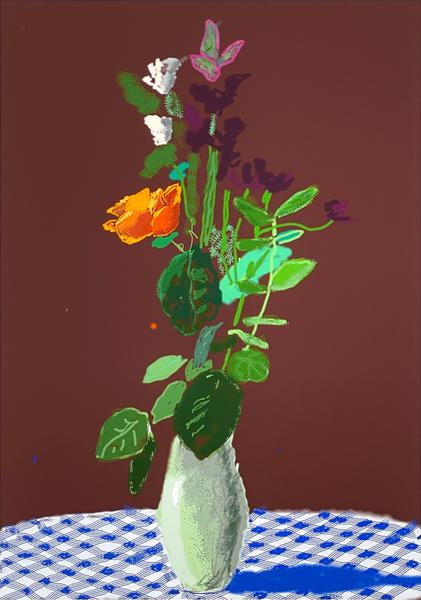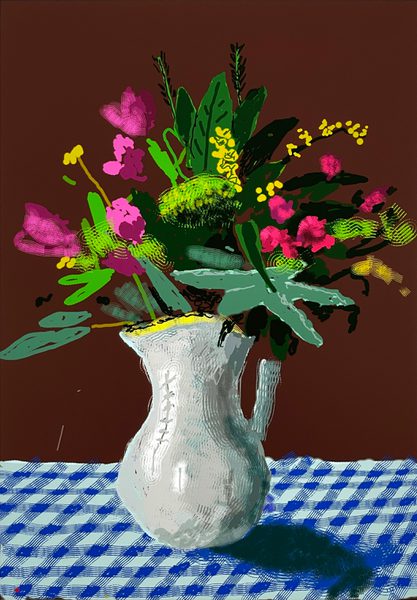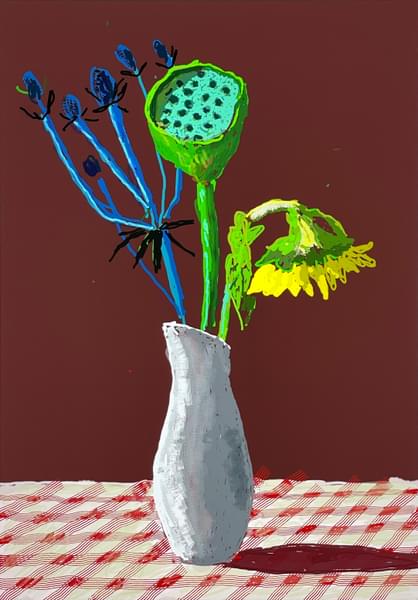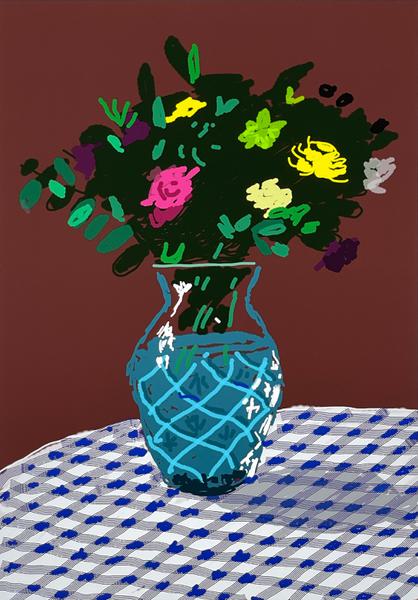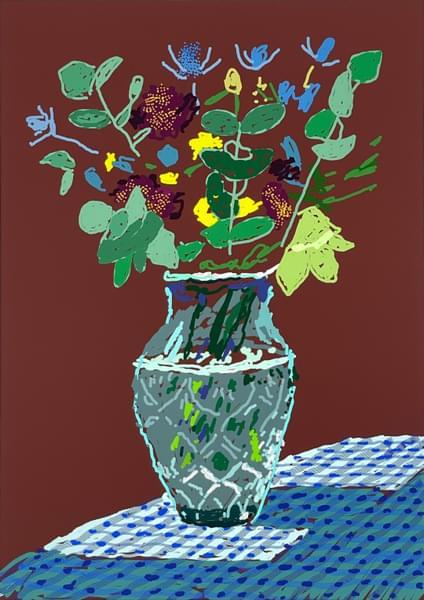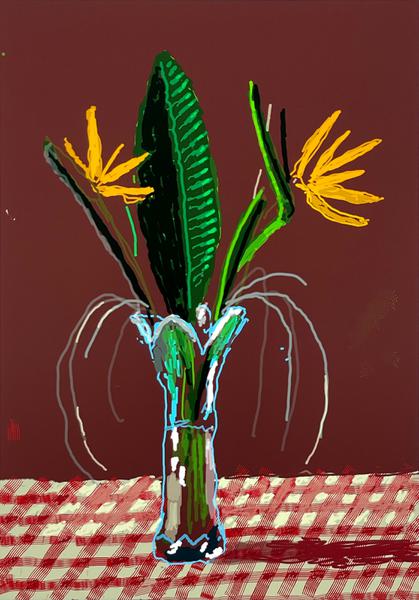Sunflower
David Hockney
In 1978 David Hockney lost his driving licence shortly before he was due to travel to America. Concerned that he might get into trouble for driving in the US without one, he decided to stay in New York a while. When a replacement caught up with him, he would travel on to California. During this enforced stay, he went upstate to Bedford, near Mount Kisco, to visit his friend the printer Ken Tyler who had a house and a workshop there. Tyler had been asking Hockney to come and make prints for ages, but Hockney wanted more than anything at that time to be left alone to paint. He had gone there with the intention of telling Ken just that: that he wanted to take a break from printmaking to concentrate on painting. Ken, however, greeted him warmly and told him that he was excited to show him a new technique involving liquid paper which he had invented for Ellsworth Kelly. The process involved making gallons of fresh paper pulp, which would be used like paint and hand-coloured whilst wet before being pressed flat. It wasn't printmaking, it was painting with the paper itself, a process that the artist had to perform himself by hand, and completely unlike any form of edition making that he had tried before. Each variant of each image would be an unique painted work: Ken had persuaded him, Hockney was hooked.
"Ken started showing me the process. I love new mediums and this was something I had never seen or used before. I think mediums can turn you on, they can excite you: they always let you do something in a different way, even if you take the same subject, if you draw it in a different way, or if you're forced to simplify it, to make it bold because it is too finicky. I like that. So I said I'll have a go and I started doing a few things, but I wasn't that keen on it at first, although I began to see that were possibilities. The process involved making a piece of paper from scratch, from rags. I had never seen paper made before: you chew up rags in the machine and it's all done with these chewed-up rags and water; you put it in the vat and you have a thin mould, which is all made of wire, and you dip the mould in the VAT, and as you pull it out, all the water runs out through the wire and this thin layer of mush stays there, and you tip it out onto a piece of felt, and when it dries it becomes a piece of paper. Or you can press it, press the moisture out, and when all the moisture is gone, all the rags stay together and it becomes a piece of paper. Ken explained that you could add dyes to the pulp and the colour will be more vivid and stronger than applying paint on the surface. I didn't quite understand, so he explained it to me again and we tried it and I began to see some possibilities.
I drew flowers at first; I thought, I like flowers, I'll draw flowers. Using this process, you are forced to be very bold, and you cannot be finicky with it, you can't use lines at all. At first I said, I love using lines, Ken, I'm not very good at using colour, bold colour, I'm too timid with it really. But gradually I realised that you could work with moulds, as if drawing the form with little metal moulds, and pour all the colours next to one another. I was drawing some flowers; I drew the leaves on the stems, and then Ken said he would make the mould of just the leaves first, and I could draw in the stems myself. We made the moulds and then I looked at it and I realised that you didn't really need the stem at all; it was there.
We were thinking that it was like a graphic process and that you made an edition, like a lithograph. We made a metal mould and we made ten of these sunflowers. But then I realised that it was totally unlike a graphic process in that I had to make each and every work myself. We weren't making prints at all. Prints, after all, are exactly the same in an edition, and these were not. I couldn't walk away and ask Ken to print them; with a lithograph I could do that. I didn't like the idea of having to do all this myself; it would be boring if they all look the same; I said, we will do you five; Ken said, we will do ten, and it took us a day to make ten."
In the end Hockney made seventeen unique painted variants of Sunflower, the first of a process he would then use to render the image of Ken Tyler's swimming pool. In all he stayed with Tyler for six weeks, making twenty-nine separate images in the new medium. Another variant of Sunflower is held in the collection of the Walker Art Center, Minneapolis.
The daring composition of the Sunflower without the stem recalls Mondrian's Red Dahlia of 1907 in the Morgan Library, as well as Matisse's famous cut-outs, which Hockney admired greatly. The choice of Sunflower as a subject had also been on Hockney's mind for the last year. In 1977 Hockney's great painting Looking at Pictures on a Screen, showing the famous curator Henry Geldzahler looking at four pictures taped to a decorative screen, included Van Gogh's Sunflowers. The picture was a homage to Hockney's four favourite pictures in London's National Gallery. Van Gogh's Sunflowers is so heavily impastoed that the connection between the thick paper pulp with which Hockney was about to work, and the bravura gestures of Van Gogh's brushstrokes, must have been made.
Sunflower, as well as the rest of the images in the Paper Pools series, is considered by the artist to be an original painting.
Hockney quotes from Nikos Stangos, David Hockney: paper pools, Thames & Hudson, London, 1980
Image 2 credit: Larry Stanton. David Hockney spoons colour pulp into a cookie-cutter mould for Sunflower 1, from the Paper Pools series, Tyler Workshop Ltd. paper mill, Bedford Village, New York, 1978
Sunflower
David Hockney
- Artist
- David Hockney (b.1937)
- Title
- Sunflower
- Title Notes
- Variant H (Paper Pool 1)
- Medium
- Unique hand-coloured pressed paper pulp, on yellow TGL handmade paper
- Date
- 1978
- Size
- 42 x 32 in : 106.7 x 81.3 cm
- Inscriptions
- Signed with the initials and dated lower right; annotated "1-H" verso (one of 17 unique variants)
- Publisher
- Published by Tyler Graphics Ltd., Mount Kisco, New York (with their inkstamp verso)
- Literature
- Tyler Graphics 236; Nikos Stangos, David Hockney: paper pools, Thames & Hudson, London, 1980, pp.20-23
- Provenance
- Tyler Graphics Ltd., New York; Private Collection, USA
- Reference
- C17-03
CURRENTLY UNAVAILABLE
Available Artists
- Andre Carl
- Avery Milton
- Baldessari John
- Bell Larry
- Brice Lisa
- Crawford Brett
- Dadamaino
- Dávila Jose
- de Tollenaere Saskia
- Downing Thomas
- Dyson Julian
- Francis Sam
- Freud Lucian
- Gadsby Eric
- Gander Ryan
- Guston Philip
- Haring Keith
- Held Al
- Hockney David
- Hui Zhang
- Kapoor Anish
- Katz Alex
- Kelly Ellsworth
- Knifer Julije
- Kusama Yayoi
- Le Parc Julio
- Leciejewski Edgar
- Léger Fernand
- Levine Chris
- LeWitt Sol
- Lichtenstein Roy
- Mangold Robert
- Maripol
- Martin Agnes
- Martin Jason
- Martin Kenneth
- Mavignier Almir da Silva
- Miller Harland
- Morellet François
- Motherwell Robert
- Nadelman Elie
- Nemours Aurélie
- O'Donoghue Hughie
- Pettibone Richard
- Picasso Pablo
- Prehistoric Objects
- Prince Richard
- Quinn Marc
- Riley Bridget
- Ruscha Ed
- Scott William
- Shrigley David
- Smith Anj
- Smith Richard
- Smith David
- Sonnier Keith
- Soto Jesús Rafael
- Soulages Pierre
- Taller Popular de Serigrafía
- The Connor Brothers
- Turk Gavin
- Vasarely Victor
- Warhol Andy
- Wesselmann Tom
- Wood Jonas
- Wool Christopher
